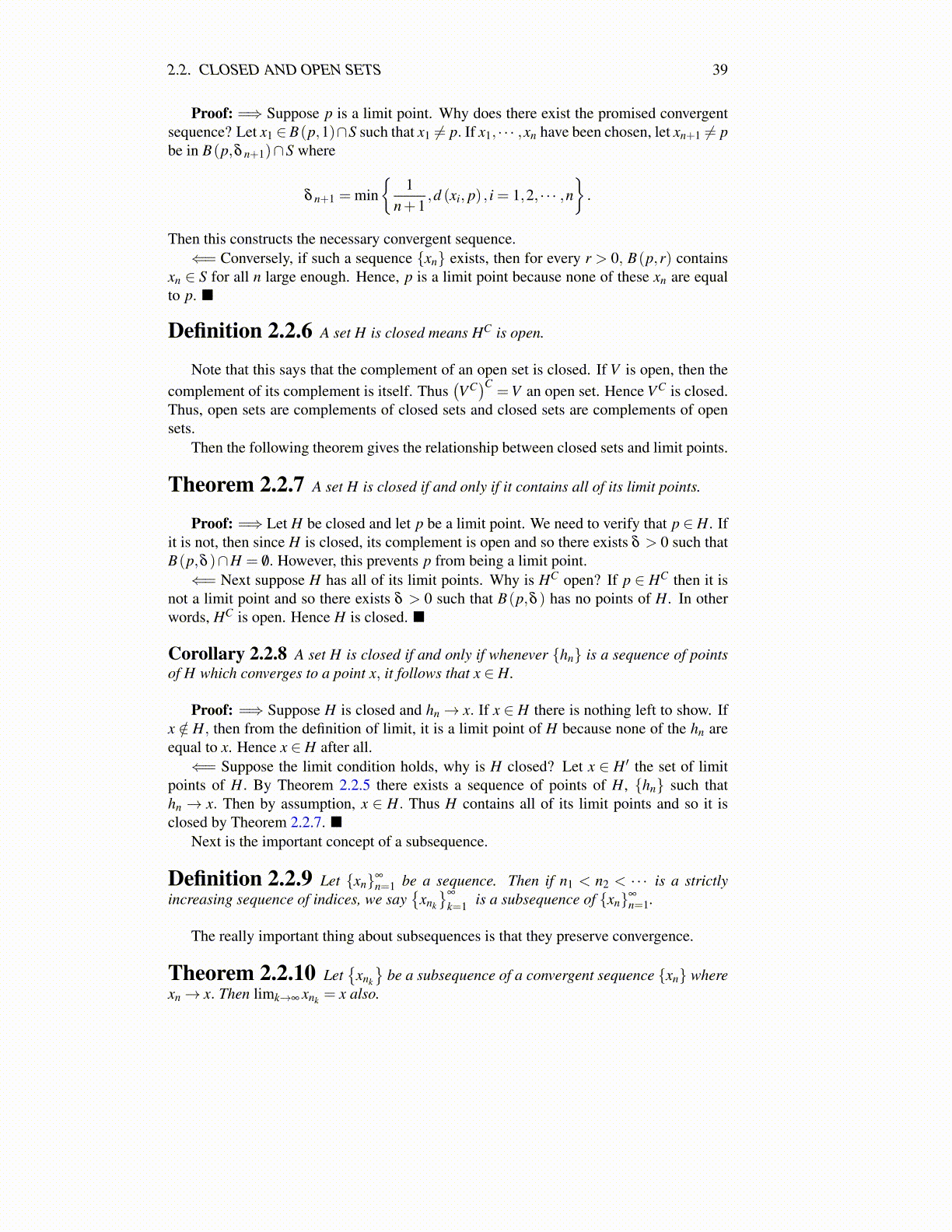
2.2. CLOSED AND OPEN SETS 39
Proof: =⇒ Suppose p is a limit point. Why does there exist the promised convergentsequence? Let x1 ∈B(p,1)∩S such that x1 ̸= p. If x1, · · · ,xn have been chosen, let xn+1 ̸= pbe in B(p,δ n+1)∩S where
δ n+1 = min{
1n+1
,d (xi, p) , i = 1,2, · · · ,n}.
Then this constructs the necessary convergent sequence.⇐= Conversely, if such a sequence {xn} exists, then for every r > 0, B(p,r) contains
xn ∈ S for all n large enough. Hence, p is a limit point because none of these xn are equalto p. ■
Definition 2.2.6 A set H is closed means HC is open.
Note that this says that the complement of an open set is closed. If V is open, then thecomplement of its complement is itself. Thus
(VC)C
=V an open set. Hence VC is closed.Thus, open sets are complements of closed sets and closed sets are complements of opensets.
Then the following theorem gives the relationship between closed sets and limit points.
Theorem 2.2.7 A set H is closed if and only if it contains all of its limit points.
Proof: =⇒ Let H be closed and let p be a limit point. We need to verify that p ∈ H. Ifit is not, then since H is closed, its complement is open and so there exists δ > 0 such thatB(p,δ )∩H = /0. However, this prevents p from being a limit point.⇐= Next suppose H has all of its limit points. Why is HC open? If p ∈ HC then it is
not a limit point and so there exists δ > 0 such that B(p,δ ) has no points of H. In otherwords, HC is open. Hence H is closed. ■
Corollary 2.2.8 A set H is closed if and only if whenever {hn} is a sequence of pointsof H which converges to a point x, it follows that x ∈ H.
Proof: =⇒ Suppose H is closed and hn→ x. If x ∈ H there is nothing left to show. Ifx /∈ H, then from the definition of limit, it is a limit point of H because none of the hn areequal to x. Hence x ∈ H after all.⇐= Suppose the limit condition holds, why is H closed? Let x ∈ H ′ the set of limit
points of H. By Theorem 2.2.5 there exists a sequence of points of H, {hn} such thathn → x. Then by assumption, x ∈ H. Thus H contains all of its limit points and so it isclosed by Theorem 2.2.7. ■
Next is the important concept of a subsequence.
Definition 2.2.9 Let {xn}∞
n=1 be a sequence. Then if n1 < n2 < · · · is a strictlyincreasing sequence of indices, we say
{xnk
}∞
k=1 is a subsequence of {xn}∞
n=1.
The really important thing about subsequences is that they preserve convergence.
Theorem 2.2.10 Let{
xnk
}be a subsequence of a convergent sequence {xn} where
xn→ x. Then limk→∞ xnk = x also.